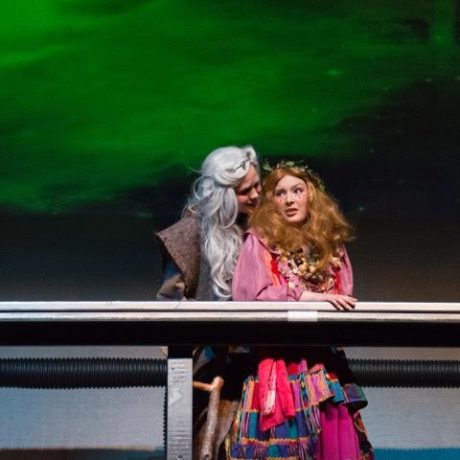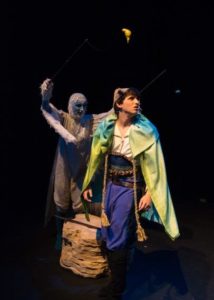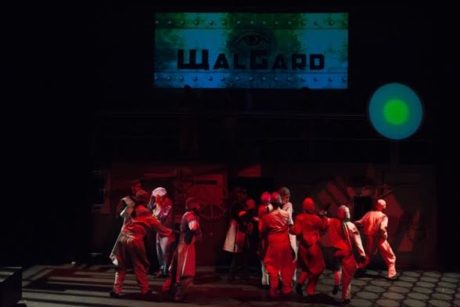The Tempest which played at The Silver Spring Black Box Theatre through May 8th was a delightful tour-de-force of sound, fury, fanfare and color. Directed and adapted by David Minton for Lumina Studio Theatre’s ensemble, The Tempest mixed Shakespeare’s vision with Minton’s vision of a dystopian future in which the eastern seaboard has been flooded by melted polar ice caps and proletariat workers manned a gigantic wall that kept out the Atlantic Ocean.

Founded in 1995, Lumina Studio Theatre features the work of over 100 young actors per season. Lumina does a great job of not only training young actors, but of putting on out-of-the-box productions. This iteration of The Tempest was no exception. Minton opted for cross-gender casting, with many females assuming male roles (ironic in that in Shakespeare’s day the casting crossed gender lines the other way.) There were also two separate casts, the Plum Cast and the Teal Cast. (This reviewer watched the Teal Cast).

There is speculation that The Tempest, William Shakespeare’s last play written without a collaborator, was his farewell to the stage, and indeed there are allusions to that theory, in that Prospero, the rightful Duke of Milan, can be seen as a sort of stand-in for Shakespeare. Bringing Prospera, the female Prospero, to life was the outstanding Grace Sperber-Whyte. Her Prospera, with her long white hair and wooden staff, was a commanding authority figure that set a dominating tone for every scene she was in.
As to the plot, it revolves, like so many Shakespearean plots, around usurped rulers, a shipwreck and unlikely love, in this case the quest of Prospera and her efforts to restore her daughter Miranda (Anna Avenesyan) to her rightful place. Prospera attempts to do this by magically conjuring up a storm to lure her sister Antonia (Callie Gompf-Phillips) and fellow usurper Queen Alonsa of Naples (the outstanding Jaydn Brick) to Prospera’s remote, isolated island.
Minton spared no creative idea when staging The Tempest, using a marching troupe of child actors in several scenes, imaginative screen projections of disaster scenes and newspaper headlines, and a mini-chorus singing various Beatles tunes. There was very much a ruling-class-vs-working class theme in Minton’s science-fiction adaptation (which was inspired by novelist Doris Lessing’s The Four Gated City).

Layered atop Shakespeare’s original characters were corresponding science-fiction styled characters from the year 2300, during the Wall Era of the Future, that at times shadowed the original characters. Prospera’s science-fiction counterpart was Prosi (Madeline Martin) for instance; Miranda’s (Anna Avenesyan) counterpart was Mir (IIan Brick) and so on.
One of the most memorable characters was Caliban (Raina Greifer), the deformed (and in this production, single-horned) son of the witch Sycorax (Anyana Greene), who plotted with Trincula the Jester (Catherine Horowitz), and Stephana the Drunk Butler (Sophia Falvey) to overthrow Prospera. Their slapstick-ish scenes were high hilarity. Falvey induced riotous laughter with her inebriated antics.
Another pivotal character was Ariel (Sophia Varnai), a sprite who works for Prospera. Ariel was resplendent in both performance and her bird-like costume—she even got to swing from a wire. There was a high degree of chemistry between Miranda (Avenesyan), Prospera’s daughter and Ferdinand (Martin Glusker), Alonsa’s son. Like a Disney cartoon come to life, Miranda and Ferdinand had the look and the body language of many a classic, screen couple.
Calibo (George Ashford) stood out in all of his scenes, with strong body language and a domineering presence. Gonzala (Makenna Beam who was double-cast in both the Plum and Teal casts and thus played every show) was strong in all her scenes, as were Alonsa (Brick) and Sebastia (Anna Brookes).
Jim Porter built a gorgeous, 1950s science-fiction style set, basically a gray wall with working gears, cranks, and meters on it that the actors physically worked. Costumers Wendy Eck and Dianne Dumais created lush and detailed costumes that dazzled and impressed, from Ariel’s white, winged bird-like outfit, to Ferdinand and Miranda’s hippie-Disney-royal attire and to Caliban’s horned-head and webbed hands and feet.
Video and Sound Engineer Ron Murphy oversaw the impressive robotic Greek-chorus audio and screen projection of characters (including Ariel “flying” over clouds), backgrounds and spinning newspaper headlines. Caliban, among other characters stood out due to the fantastic makeup work done by Make-up Designers Liz Porter and Carl Randolph. The show featured strong choreography by Sylvie Weissman, Sperber-Whyte, and Keegan Vernon-Clay.

Lumina Studio Theatre’s The Tempest was a stunning spectacle of superior stage craft, the kind of collective performance that “dreams are made of.”
Running Time: Two hours and 45 minutes, with a 15-minute intermission.
The Tempest played through April 8, 2016 at Lumina Studio Theatre at Silver Spring Black Box Theatre – 8641 Colesville Road, in Silver Spring, MD.
RATING:




